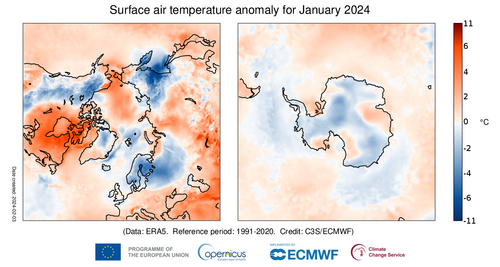January 2024 was the warmest January on record globally, with an average ERA5 surface air temperature of 13.14°C, 0.70°C above the 1991-2020 average for January and 0.12°C above the temperature of the previous warmest January, in 2020. The global temperature anomaly for January 2024 was lower than those of the last six months of 2023, but higher than any before July 2023. The month was 1.66°C warmer than an estimate of the January average for 1850-1900, the designated pre-industrial reference period. The global mean temperature for the past twelve months (Feb 2023 – Jan 2024) is the highest on record, at 0.64°C above the 1991-2020 average and 1.52°C above the 1850-1900 pre-industrial average. European temperatures varied in January 2024 from much below the 1991-2020 average over the Nordic countries to much above average over the south of the continent.
Outside Europe, temperatures were well above average over eastern Canada, north-western Africa, the Middle East and central Asia, and below average over western Canada, the central USA and most of eastern Siberia. The El Niño began to weaken in the equatorial Pacific, but marine air temperatures in general remained at an unusually high level.
The average global sea surface temperature (SST) for January over 60°S–60°N reached 20.97°C, a record for January, 0.26°C warmer than the previous warmest January, in 2016, and second highest value for any month in the ERA5 dataset, within 0.01°C of the record from August 2023 (20.98°C). Since 31 January, the daily SST for 60°S–60°N has reached new absolute records, surpassing the previous highest values from 23–24 August 2023.
For more information visit climate.copernicus.eu

